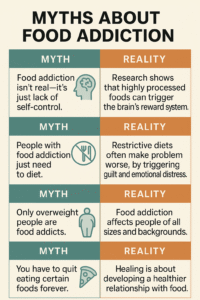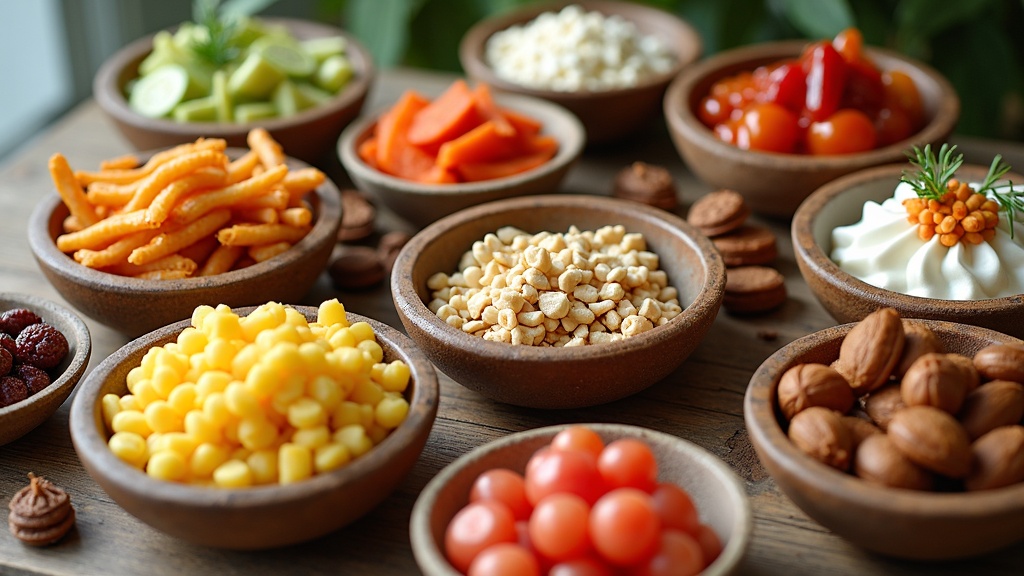If you’ve ever found yourself scarfing down cookies you didn’t plan to eat or questioning if your pizza cravings are stronger than most people’s, you’ve probably heard the phrase “food addiction.” People often toss it around in everyday conversations or online, describing powerful urges for chips, chocolate, or fries. But is food addiction a real thing, or just our way of excusing a love for tasty stuff? Let’s dig into the myths, facts, and science behind food addiction, so you can actually get a sense of what’s happening when those cravings hit.
What is Food Addiction, Really?
Food addiction describes intense cravings or compulsive eating that feels out of control. It usually centers on foods loaded with sugar, fat, or salt—like potato chips, doughnuts, or double cheeseburgers. Some people say they can’t stop eating these foods, no matter how hard they try.
The term itself isn’t something you’ll find officially listed in medical manuals like the DSM-5 (which covers disorders like depression or alcohol addiction). Instead, professionals use related diagnoses such as binge eating disorder. Still, the way people talk about food addiction suggests a powerful pull, which keeps it trending in both scientific studies and everyday life.
Part of the idea comes from research showing that certain brains light up with pleasure when eating particular foods. This is similar (but not the same) to what happens with gambling or drug use. But that similarity doesn’t mean food addiction plays by the same rules, and it opens up questions that deserve a closer look.
Common Myths About Food Addiction
This topic can get pretty confusing, thanks to all the misinformation. Here are a few myths I’ve heard most often:
- Myth 1: Certain Foods Are Addictive for Everyone
Not everyone reacts the same way to food. Even though lots of people love chocolate, not everyone feels “addicted” to it. Genetics, emotions, and personal history all play a role in developing eating patterns that look like addiction. - Myth 2: Food Addiction is Just a Lack of Willpower
People dealing with overeating or cravings often blame themselves for being weak. However, research shows that brain chemistry, emotional stress, and restricting food can worsen cravings. Blaming willpower alone glosses over these real factors. - Myth 3: Food Addiction and Drug Addiction Are Basically the Same
There’s some overlap but significant differences, especially in brain reward pathways. For example, you can cut out alcohol, but you can’t quit food and stay healthy. Food is woven into our social lives and emotions in ways drugs aren’t. - Myth 4: All Cravings Mean You’re Addicted
Cravings are just part of being human. Wanting pizza or ice cream doesn’t equal addiction. Real food addiction is a repeated cycle of loss of control, distress, and interference with everyday life.
Understanding Why Food Feels So Rewarding
Ever found yourself unable to stop eating chips, even when you’re not hungry? Scientists say foods high in sugar, fat, and salt can fire up dopamine—your brain’s feel-good chemical. We’re wired this way because, back then, our bodies needed calorie-dense foods to survive tough times.
Big food companies know this and mix up just the right flavors, textures, and smells to keep you coming back. This setup doesn’t make food “addictive” like drugs, but it sure makes it easy to fall into patterns of overeating—especially when you’re bored, stressed, or tired.
Your environment matters a lot, too. If you keep treats in every drawer or live near tons of fast food, resisting temptation can quickly become exhausting. Habits build soon under these conditions, so it’s understandable when food seems to take over.
How Professionals Assess Food Addiction
Researchers use questionnaires like the Yale Food Addiction Scale to get a read on food-related behaviors that look like substance use disorders. The survey checks for things like:
- Craving or constant thoughts about a specific food
- Repeated failed efforts to cut back
- Feeling physically unwell when you can’t eat certain foods
- Spending lots of time getting, eating, or recovering from a food binge
- Eating even when it causes issues at home, work, or school
Overeating now and then doesn’t check these boxes. Sometimes, overeating is just a way to handle stress, fight boredom, or react to long-term dieting—not addiction. Getting a complete picture means looking at eating patterns and emotional health together.
Food Addiction vs. Other Eating Issues
The line between food addiction, binge eating disorder, and emotional eating can be fuzzy. Here’s what you’ll likely see:
- Binge Eating Disorder: Regularly eating substantial amounts of food, feeling out of control, and feeling upset or distressed afterwards. This has a formal diagnosis in the DSM-5.
- Emotional Eating: Turning to food when you’re stressed, sad, or bored. Not the same as addiction, but it can still lead to overeating cycles.
Sometimes people label intense cravings as food addiction, even though they don’t actually meet the official standard for a disorder. Knowing the difference can help you get the right kind of support.
What Actually Helps with Food Cravings?
You’re not stuck if you’re battling cravings or caught in a frustrating pattern with food. Here are some tried-and-true ways to handle it:
- Eat Regular Meals: Skipping meals or cutting calories way too low typically boosts cravings later. Regular meals keep your blood sugar even and keep “hangry” urges at bay.
- Address Stress Without Food: Stress, sadness, or boredom can make snacking tempting. To break the pattern, try a walk, call a friend, or get into a hobby instead.
- Make Your Space Work for You: Hide the snacks or swap them for foods that fill you up but don’t lead to binges. Sometimes, out of sight really does mean out of mind.
- Reach Out for Support: If food runs your life, connecting with a registered dietitian, therapist, or group can provide fresh coping skills with zero judgment.
- Balance, Not Perfection: Diets that are too restrictive can ramp up cravings and loss of control. Permitting yourself to eat all foods (no guilt!) helps you eat mindfully and avoid the restrict-then-binge rollercoaster.
Things to Consider Before Labeling Yourself As “Food Addicted”
It’s easy to feel broken when you hear the term ‘food addiction’. But remember, so many factors influence how and why we eat—your past, environment, and feelings all matter a lot more than sheer willpower. Before you give yourself this label, try these steps:
- Ask Where the Craving Comes From: Are you really hungry, just tired, a bit upset, or simply snacking as part of a routine?
- Notice Patterns: Keep a quick journal for several days to track when your cravings spike. See if you can spot triggers—like work stress, late hours, or skipped meals.
- Recognize Diet Culture: Diets restricting certain foods often lead to cravings and guilt, making it hard to break the cycle.
- Look for Strength in Seeking Support: Feeling “addicted” sometimes carries stigma, but you’d be surprised how common it is. Reaching out is a sign of strength, not weakness—asking for help is always okay.
How Marketing and Language Shape Food Beliefs
Food products, especially snacks and desserts, are often sold as “guilt-free,” “irresistible,” or even “sinful. ” These labels make ordinary cravings seem like something wrong. Spotting this marketing tactic helps you take control over your relationship with food.
Physical vs. Emotional Cravings
Cravings aren’t just about hunger. Sometimes, your body really does need fuel. Other times, you truly crave comfort, distraction, or relief from boredom. Getting in tune with your body means learning the difference—sometimes food is the answer, but sometimes you need a change of pace or a little self-care.
Frequently Asked Questions
Some of the biggest questions people have about food addiction and cravings include:
Question: Is food addiction the same as binge eating disorder?
Answer: Not exactly. Binge eating disorder is an official diagnosis; food addiction is a description people use for intense cravings. They can overlap, but not everyone with cravings fits a disorder.
Question: Can certain foods really “hook” your brain?
Answer: Some foods are scientifically crafted to be super tasty and hit all the pleasure buttons in your brain. That can absolutely make you want more, but it isn’t the same as a drug addiction with withdrawal symptoms.
Question: How do I know if I need help?
Answer: If eating causes you distress, takes up lots of your energy, or gets in the way of your life, a chat with a dietitian or therapist can be super helpful.
Takeaways to Remember
Sorting fact from fiction about food addiction is essential if you want a better relationship with eating. The science keeps evolving about how the brain responds to snacks and sugar, but harsh labels like “addict” rarely help. Listen to what you need, create habits that make sense for your life, and don’t be shy about seeking help—cravings are simply part of being human, not a flaw you must fix.
If this feels personal, know you’re not the only one. You can always look for support that matches your story, because you deserve to feel good about food and yourself.
Video: Is Food Addiction Real or Just a Myth?

